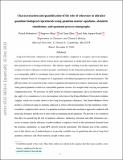Characterization and Quantification of the Role of Coherence in Ultrafast Quantum Biological Experiments Using Quantum Master Equations, Atomistic Simulations, and Quantum Process Tomography
Published Version
https://doi.org/10.1016/j.proche.2011.08.041Metadata
Show full item recordCitation
Rebentrost, Frank Patrick, Sangwoo Shim, Joel Yuen-Zhou, and Alán Aspuru-Guzik. 2011. Characterization and quantification of the role of coherence in ultrafast quantum biological experiments using quantum master equations, atomistic simulations, and quantum process tomography. Procedia Chemistry 3(1): 332–346.Abstract
Long-lived electronic coherences in various photosynthetic complexes at cryogenic and room temperature have generated vigorous efforts both in theory and experiment to understand their origins and explore their potential role to biological function. The ultrafast signals resulting from the experiments that show evidence for these coherences result from many contributions to the molecular polarization. Quantum process tomography (QPT) is a technique whose goal is that of obtaining the time-evolution of all the density matrix elements based on a designed set of experiments with different preparation and measurements. The QPT procedure was conceived in the context of quantum information processing to characterize and understand general quantum evolution of controllable quantum systems, for example while carrying out quantum computational tasks. We introduce our QPT method for ultrafast experiments, and as an illustrative example, apply it to a simulation of a two-chromophore subsystem of the Fenna-Matthews-Olson photosynthetic complex, which was recently shown to have long-lived quantum coherences. Our Fenna-Matthews-Olson model is constructed using an atomistic approach to extract relevant parameters for the simulation of photosynthetic complexes that consists of a quantum mechanics/molecular mechanics approach combined with molecular dynamics and the use of state-of-the-art quantum master equations. We provide a set of methods that allow for quantifying the role of quantum coherence, dephasing, relaxation and other elementary processes in energy transfer efficiency in photosynthetic complexes, based on the information obtained from the atomistic simulations, or, using QPT, directly from the experiment. The ultimate goal of the combination of this diverse set of methodologies is to provide a reliable way of quantifying the role of long-lived quantum coherences and obtain atomistic insight of their causes.Other Sources
http://arxiv.org/abs/1012.3451Terms of Use
This article is made available under the terms and conditions applicable to Open Access Policy Articles, as set forth at http://nrs.harvard.edu/urn-3:HUL.InstRepos:dash.current.terms-of-use#OAPCitable link to this page
http://nrs.harvard.edu/urn-3:HUL.InstRepos:8404292
Collections
- FAS Scholarly Articles [18292]
Contact administrator regarding this item (to report mistakes or request changes)



